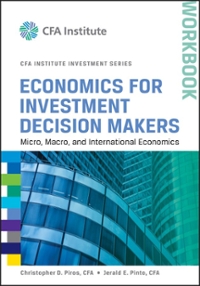Question
You invested $1000 in a stock at the start of the year 2016. The return on your stock is 50% in year 2016; 50% in
-
You invested $1000 in a stock at the start of the year 2016. The return on your stock is 50% in year 2016; 50% in year 2017, and 33.3% in year 2018. What is the arithmetic average return per year? How much money do you have at the end of 2018?
-
A) 0%; you have $1000
-
B) 33.3%; you have $1333
-
C) 33.3%; you have $1000
-
D) 11.1%; you have $1000
-
E) 11.1%; you have $1333
-
-
You sold short 300 shares of common stock at $55 per share. The initial margin is 60%. At what stock price (to the nearest whole dollar) would you receive a margin call if the maintenance margin is 35%?
-
You buy 300 shares of Qualitycorp for $30 per share and deposit initial margin of 50%. The next day Qualitycorp's price drops to $25 per share. What is your margin when the stock price is at $25?
2
Use the following information for questions 5 and 6:
Your portfolio consists of the following three stocks:
Stock X Y Z
Start price $50
$40 $30
End price $30
$45 $50
Number of shares 100
200 300
.
.
5. The value-weighted return on your portfolio is A) 18.5% B) 22.7% C) 4.17%
D) 0% E) Impossible to determine
6. The equal-weighted return on your portfolio is
-
A) 5%
-
B) 13.1%
-
C) 39.2%
-
D) 0%
-
E) Impossible to determine
7. You want to buy 100 shares of Hotstock Inc. at the best available price as quickly as possible. You would most likely place a
-
A) stop-loss order
-
B) stop-buy order
-
C) limit-buy order
-
D) limit-sell order
-
E) market buy order
3
-
You are a long-term investor. You plan to buy a mutual fund and hold it for 40 years. You would prefer which of the following?
-
A) A mutual fund with a large front-end load and no expense ratio
-
B) A mutual fund with no loads and a high expense ratio
-
-
Most actively managed mutual funds, when compared to a market index such as the S&P 500,
-
A) Beat the market return in all years.
-
B) Beat the market return in most years.
-
C) Do not outperform the market.
-
D) None of the above is a correct statement
-
-
A mutual fund has a portfolio currently worth $215 million. It has 10 million shares outstanding. The funds NAV per share equals .
-
A) $21.50
-
B) $2.15 billion
-
C) $20.60
-
D) $215 million
-
E) $22.40
-
PLEASE GIVE EXPLANATIONS FOR THE ANSWERS
Step by Step Solution
There are 3 Steps involved in it
Step: 1

Get Instant Access to Expert-Tailored Solutions
See step-by-step solutions with expert insights and AI powered tools for academic success
Step: 2

Step: 3

Ace Your Homework with AI
Get the answers you need in no time with our AI-driven, step-by-step assistance
Get Started


